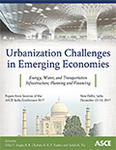ASCE India Conference 2017
Prediction of Settlement of Road Embankment Using Electrical Resistivity Tomography (ERT)
Publication: Urbanization Challenges in Emerging Economies: Energy and Water Infrastructure; Transportation Infrastructure; and Planning and Financing
ABSTRACT
Electrical resistivity tomography (ERT) is a non-invasive sub-surface technique which is widely used for investigation of various geological and engineering problems. The conventional test includes soil boring and collection of soil samples for finding out the subsurface soil profile and engineering behavior of soil. These conventional tests are borehole specific and cannot give an overall picture of the subsurface, particularly when the investigation area is large and heterogeneous. In such a condition, geophysical tests like ERT, seismic refraction, spectral analysis of surface waves, etc., are worthy, economic, and time efficient but the accuracy and reliability depend upon the accuracy in interpretation of the field data. The present study consists of performing ERT along a newly constructed bypass road which showed sinking in some locations during embankment construction. The survey gave a clear picture of the subsurface soil profile and the extent of penetration of top stiff soil into the soft organic stratum below. Some boreholes were also dug in the affected area to confirm the ERT results. It is observed that the ERT gives a better prediction of soil behavior in an erratic site.
Get full access to this article
View all available purchase options and get full access to this chapter.
REFERENCES
Chambers, J. E., Gunn, D. A., Wilkinson, P. B., Meldrum, P. I., Haslam, E., Holyoake, S., Kirkham, M., Kuras, O., Merritt, A., and Wragg, V. (2014). “4D electrical resistivity tomography monitoring of soil moisture dynamics in an operational railway embankment.” Near Surface Geophysics., 12, 61-72.
Cho, I. and Yeom, J.(2007).“Crossline resistivity tomography for the delineation of anomalous seepage pathways in an embankment dam.” Geophysics., 72(2), G31-G38.
Gance, J., Malet, J. P., Supper, R., Sailhac, P., Ottowitz, D., and Jochumb, B., (2016). “Permanent electrical resistivity measurements for monitoring water circulation in clayey landslides.”J. of Applied Geophysics, 126, 98-115.
Gay, D. A., Morgan, F.D., Vichabian, Y., Sogade, J.A., Reppert, P., and Wharton, A.E., (2006). “Investigations of andesitic volcanic debris terrains: Part 2.” Geotechnical. Geophysics., 71, B9-B15.
Gunn, D. A., Chambers, J. E., Uhlemann, S., Wilkinson, P.B., Meldrum, P.I., Dijkstra, T. A., Haslam, E., Kirkham, M., Wragg, J., Holyoake, S., Hughes, P.N., Hen-Jones, R., and Glendinning, S., (2015). “Moisture monitoring in clay embankments using electrical resistivity Tomography.” Construction and Building Materials., 92, 82-94.
Institute of Electrical and Electronics Engineers : 142. (2007). IEEE Recommended Practice for Grounding of Industrial and Commercial Power Systems, IEEE Std.
IS:1498 (1970). “Classification and Identification of soils for general Engineering purposes”. Bureau of Indian Standards, New Delhi.
IS:2131 (1981). “Method for standard Penetration test for soils”. Bureau of Indian Standards, New Delhi.
Israil, M. and Pachauri, A. K. (2003). “Geophysical characterization of a landslide site in the Himalayan foothill region”. J. of Asian Earth Sciences., 22, 253-263.
Ling, C., Qiang, Xua., Qiang, Z., Jiaxin, R., and Hongbin, L. (2016). “Application of electrical resistivity tomography for investigating the internal structure of a translational landslide and characterizing its groundwater circulation (Kualiangzi landslide, Southwest China).” J. of Applied Geophysics., 131, 154-162.
Loke, M. H. (2001). Tutorial : 2-D and 3-D electrical imaging surveys, http://www.geoelectrical.com.
Loke, M. H. and Barker, R. D. (1996). “Practical techniques for 3D resistivity survey and data inversion.” Geopgysical Prospecting., 44, 499-523.
Samouëlian, A., Cousin, I., Tabbagh, A., Bruand, A., and Richard, G. (2005). “Electrical resistivity survey in soil science: a review.” Soil & Tillage Research., 83, 173-193.
Thabit, J. M. and Al-Zubedi, A. S. (2015). “Evaluation of Three Important Electrode Arrays in Defining the Vertical and Horizontal Structures in 2D Imaging Surveys.” Iraqi J. of Science., 56(2B), 1465-1470.
Information & Authors
Information
Published In
Urbanization Challenges in Emerging Economies: Energy and Water Infrastructure; Transportation Infrastructure; and Planning and Financing
Pages: 639 - 648
Editors: Udai P. Singh, B. R. Chahar, Indian Institute of Technology, H. R. P. Yadav, Institution of Engineers (India), and Satish K. Vij
ISBN (Online): 978-0-7844-8202-5
Copyright
© 2018 American Society of Civil Engineers.
History
Published online: Dec 13, 2018
Authors
Metrics & Citations
Metrics
Citations
Download citation
If you have the appropriate software installed, you can download article citation data to the citation manager of your choice. Simply select your manager software from the list below and click Download.
